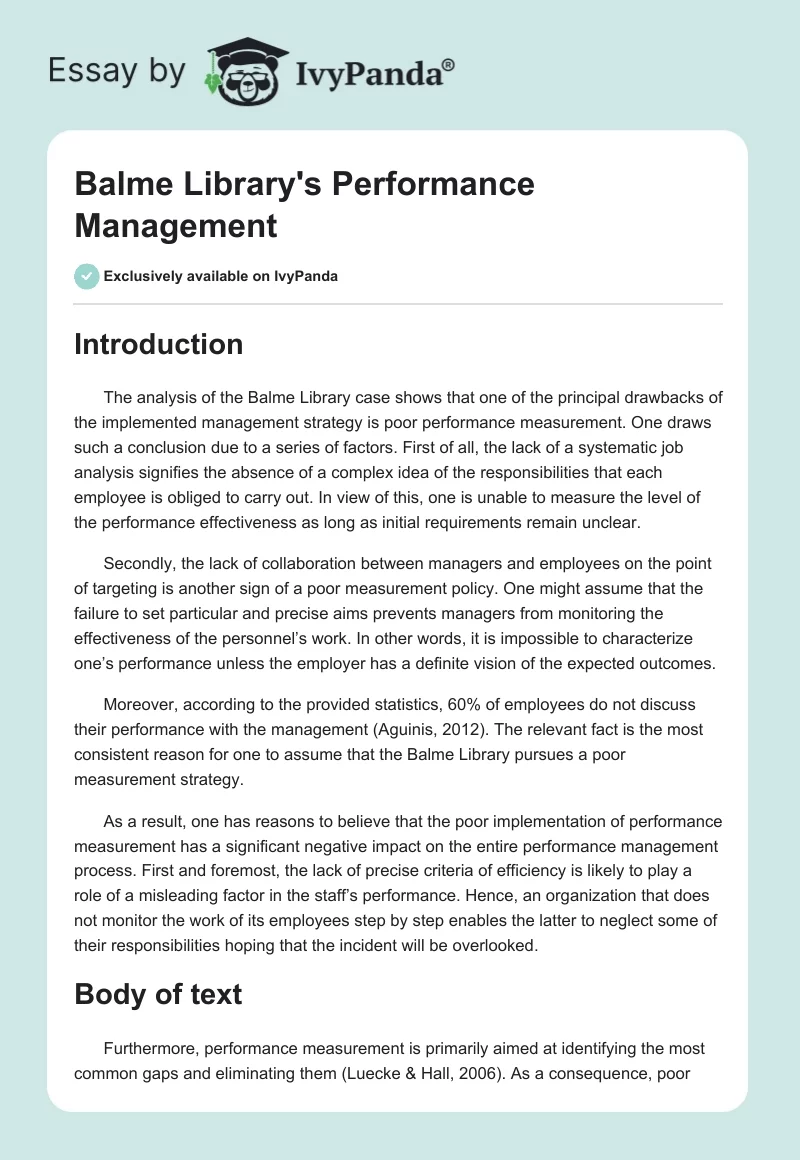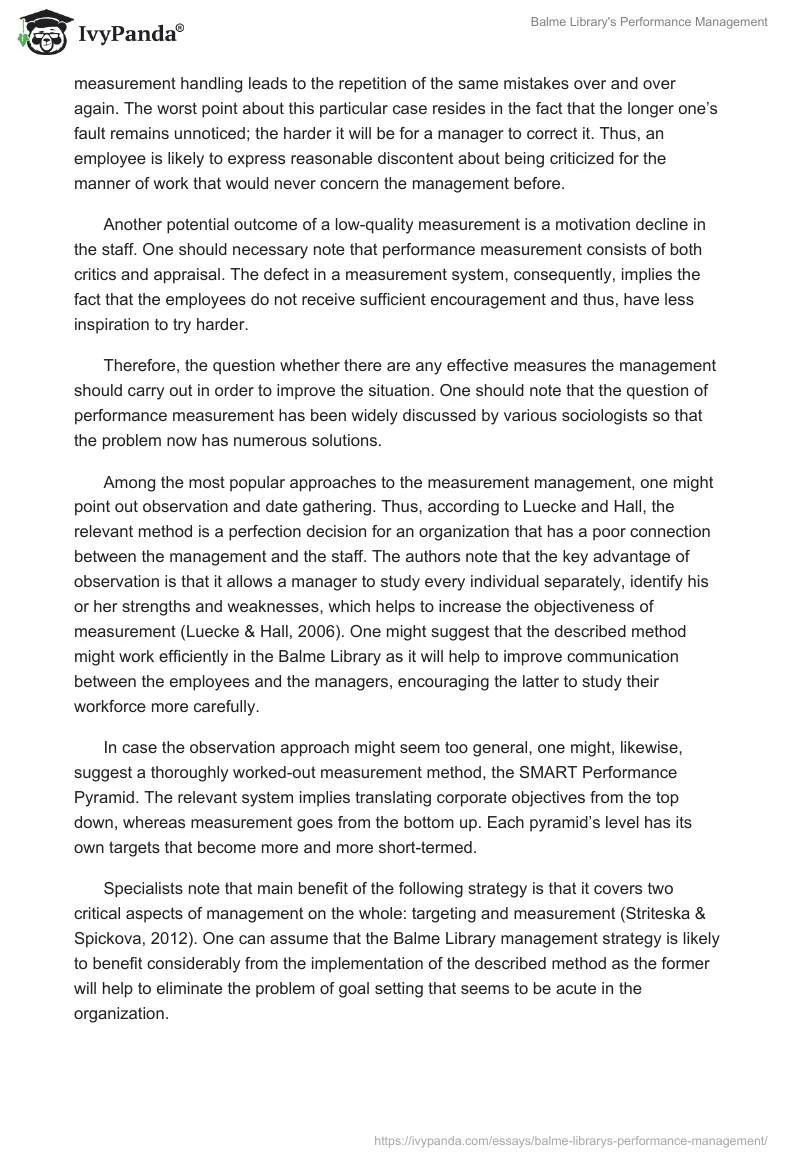Introduction
The analysis of the Balme Library case shows that one of the principal drawbacks of the implemented management strategy is poor performance measurement. One draws such a conclusion due to a series of factors. First of all, the lack of a systematic job analysis signifies the absence of a complex idea of the responsibilities that each employee is obliged to carry out. In view of this, one is unable to measure the level of the performance effectiveness as long as initial requirements remain unclear.
Secondly, the lack of collaboration between managers and employees on the point of targeting is another sign of a poor measurement policy. One might assume that the failure to set particular and precise aims prevents managers from monitoring the effectiveness of the personnel’s work. In other words, it is impossible to characterize one’s performance unless the employer has a definite vision of the expected outcomes.
Moreover, according to the provided statistics, 60% of employees do not discuss their performance with the management (Aguinis, 2012). The relevant fact is the most consistent reason for one to assume that the Balme Library pursues a poor measurement strategy.
As a result, one has reasons to believe that the poor implementation of performance measurement has a significant negative impact on the entire performance management process. First and foremost, the lack of precise criteria of efficiency is likely to play a role of a misleading factor in the staff’s performance. Hence, an organization that does not monitor the work of its employees step by step enables the latter to neglect some of their responsibilities hoping that the incident will be overlooked.
Body of text
Furthermore, performance measurement is primarily aimed at identifying the most common gaps and eliminating them (Luecke & Hall, 2006). As a consequence, poor measurement handling leads to the repetition of the same mistakes over and over again. The worst point about this particular case resides in the fact that the longer one’s fault remains unnoticed; the harder it will be for a manager to correct it. Thus, an employee is likely to express reasonable discontent about being criticized for the manner of work that would never concern the management before.
Another potential outcome of a low-quality measurement is a motivation decline in the staff. One should necessary note that performance measurement consists of both critics and appraisal. The defect in a measurement system, consequently, implies the fact that the employees do not receive sufficient encouragement and thus, have less inspiration to try harder.
Therefore, the question whether there are any effective measures the management should carry out in order to improve the situation. One should note that the question of performance measurement has been widely discussed by various sociologists so that the problem now has numerous solutions.
Among the most popular approaches to the measurement management, one might point out observation and date gathering. Thus, according to Luecke and Hall, the relevant method is a perfection decision for an organization that has a poor connection between the management and the staff. The authors note that the key advantage of observation is that it allows a manager to study every individual separately, identify his or her strengths and weaknesses, which helps to increase the objectiveness of measurement (Luecke & Hall, 2006). One might suggest that the described method might work efficiently in the Balme Library as it will help to improve communication between the employees and the managers, encouraging the latter to study their workforce more carefully.
In case the observation approach might seem too general, one might, likewise, suggest a thoroughly worked-out measurement method, the SMART Performance Pyramid. The relevant system implies translating corporate objectives from the top down, whereas measurement goes from the bottom up. Each pyramid’s level has its own targets that become more and more short-termed.
Specialists note that main benefit of the following strategy is that it covers two critical aspects of management on the whole: targeting and measurement (Striteska & Spickova, 2012). One can assume that the Balme Library management strategy is likely to benefit considerably from the implementation of the described method as the former will help to eliminate the problem of goal setting that seems to be acute in the organization.
The library might, likewise, try a similar strategy called the Performance Prism, where the idea of the pyramid is replaced by a concept of a multi-level prism. According to the researchers, this method is likely to be particularly efficient in organizations that are willing to build their measurement system from scratch (Striteska & Spickova, 2012).
Conclusion
Finally, as long as an appropriate measurement policy is selected, one might, additionally, recommend implementing an effective measurement tool, MAART chart. The instrument is represented by a dashboard that assists managers in monitoring, tracking, and correcting the staff’s performance. The method is particularly useful for identifying current flaws and mistakes (Romaniello, Renna, & Cinque, 2011). One believes that the implementation of the MAART chart tool is likely to make the measurement system of the library more systematic and transparent.
References
Aguinis, H. (2012). Performance Management. Upper Saddle River, New Jersey: Prentice Hall.
Luecke, R., & Hall, B.J. (2006). Performance Management: Measure and Improve the Effectiveness of Your Employees. Boston, Massachusetts: Harvard Business Press.
Romaniello, V., Renna, P., & Cinque, V. (2011). A Continuous Improvement and Monitoring Performance System: Monitor – Analysis -Action – Review (MAAR) Charts. IBIMA Business Review, 2011(2011), 15. Web.
Striteska, M., & Spickova, M. (2012). Review and Comparison of Performance.
Measurement Systems. Journal of Organizational Management Studies, 2012(2012), 13. Web.


